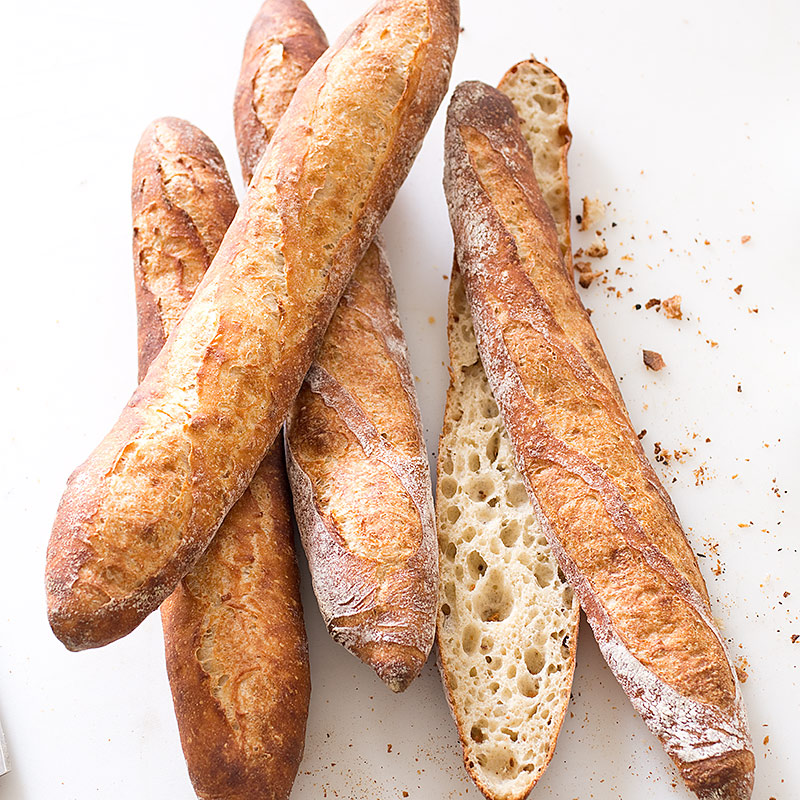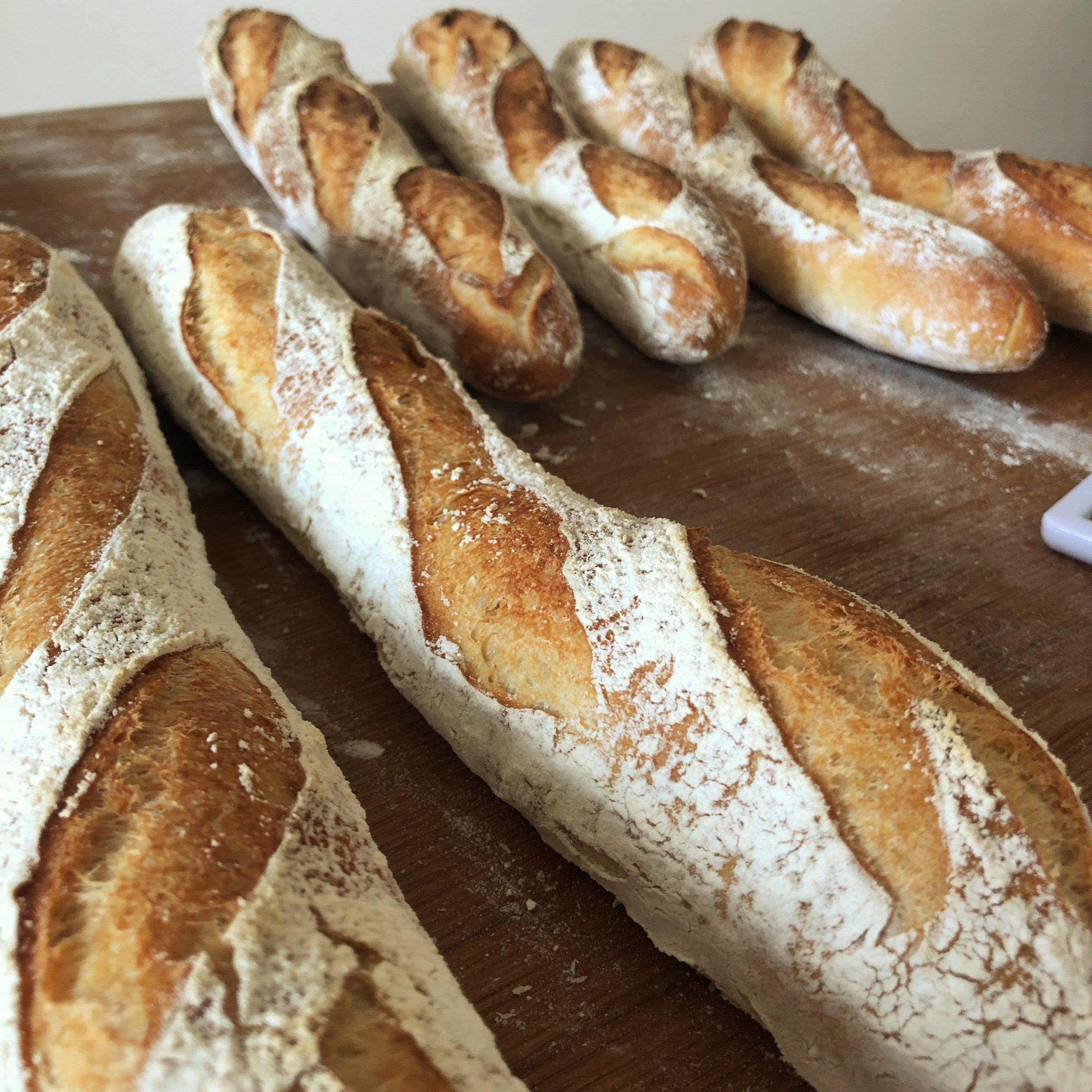Embark on a culinary adventure as we delve into the secrets of crafting an authentic French baguette, a bread that has captivated taste buds for centuries. This humble loaf, with its golden-brown crust and chewy interior, is a cornerstone of French cuisine, embodying the essence of simplicity and perfection.
In this comprehensive guide, we will explore the intricacies of creating this culinary masterpiece, from selecting the finest ingredients to mastering the delicate art of shaping and baking. Whether you are a seasoned baker or a novice enthusiast, this journey will equip you with the knowledge and techniques to recreate the authentic flavors and textures of a true French baguette.
Ingredients and Equipment
Creating an authentic French baguette requires a careful selection of ingredients and specialized equipment. The essential components play crucial roles in achieving the characteristic crust, airy crumb, and distinct flavor of a traditional baguette.
The primary ingredients include:
- High-quality flour: Strong bread flour with a high protein content (12-14%) provides the structure and gluten formation necessary for a well-developed crust and chewy interior.
- Water: The hydration level of the dough is critical. Using cold water slows down yeast activity, allowing for a longer fermentation time and better flavor development.
- Yeast: Fresh or active dry yeast initiates fermentation, converting sugars in the flour into carbon dioxide gas, which creates the characteristic holes in the bread.
- Salt: A small amount of salt enhances the flavor and strengthens the gluten network, contributing to a crispy crust.
Specialized Equipment
In addition to the ingredients, specialized equipment is essential for shaping and baking a baguette:
- Banneton or couche: These proofing baskets or cloths provide support and shape to the dough during the final rise, creating the characteristic elongated form of a baguette.
- Lame or sharp knife: A sharp lame or knife is used to score the surface of the dough before baking, allowing it to expand properly in the oven.
- Baking stone or baking sheet: A preheated baking stone or baking sheet provides an even heat distribution, resulting in a crispy crust and evenly baked bread.
Mixing and Kneading the Dough
Mixing and kneading the dough are crucial steps in crafting an authentic French baguette. The process involves combining the ingredients, developing gluten, and achieving the proper dough consistency and elasticity.
Hydration Levels
The hydration level of the dough, expressed as a percentage, refers to the amount of water used in relation to the flour weight. A higher hydration level (e.g., 65-75%) results in a more open and airy crumb, while a lower hydration level (e.g.,
55-65%) produces a denser and chewier baguette.
Kneading Techniques
Kneading develops the gluten network within the dough, giving it strength and elasticity. There are two main kneading techniques:
- French Kneading: Involves stretching and folding the dough repeatedly, mimicking the motion of kneading bread by hand.
- Machine Kneading: Uses a stand mixer or bread machine to knead the dough, providing a more efficient and consistent result.
Proper Dough Consistency and Elasticity
The ideal dough consistency for a baguette is slightly sticky but not overly wet. It should be able to hold its shape when stretched, but also spring back when released. Elasticity, or the ability of the dough to stretch without tearing, is achieved through the development of the gluten network.
Fermentation and Shaping
Fermentation is a crucial step in the baguette-making process, responsible for developing its distinctive flavor and aroma. It involves the conversion of sugars in the dough into carbon dioxide and other compounds by yeast, resulting in the characteristic airy texture and tangy taste of the bread.
There are two primary fermentation methods used in baguette making:
Bulk Fermentation
- Involves allowing the dough to rise as a whole mass after mixing and kneading.
- This method helps develop gluten strength and flavor while allowing for even fermentation throughout the dough.
Proofing
- The second fermentation stage, where the shaped dough pieces are allowed to rise individually before baking.
- Proofing helps the dough expand further and develop its final shape.
Once the dough has fermented, it’s time to shape the baguettes. This involves dividing the dough into equal pieces, shaping them into long, slender loaves, and scoring the surface to allow for expansion during baking.
Scoring Techniques
- Slashing: Making diagonal cuts across the surface of the dough with a sharp knife or razor blade.
- Snipping: Using scissors to make small, even cuts along the length of the dough.
- Dockering: Pricking the surface of the dough with a fork or docking tool to create small holes.
Proper scoring allows for controlled expansion during baking, preventing the baguettes from bursting or becoming misshapen.
Baking and Cooling

Baking a baguette requires precision and attention to detail. The optimal baking temperature is between 450°F (230°C) and 500°F (260°C), which creates a golden-brown crust while ensuring a chewy interior.Steam plays a crucial role in achieving the signature crispy crust.
Before baking, inject steam into the oven using a spray bottle or place a pan of hot water on the bottom rack. This creates a humid environment that promotes crust formation.Once baked, let the baguette cool on a wire rack for at least 30 minutes before slicing.
This allows the bread to release excess moisture and develop its full flavor and texture.
Cooling
Proper cooling preserves the baguette’s texture and flavor. Cooling on a wire rack allows air to circulate around the bread, preventing it from becoming soggy. Avoid wrapping the baguette in plastic wrap or aluminum foil while it’s still warm, as this traps moisture and makes the crust soft.
Serving and Enjoying

The authentic French baguette is a versatile bread that can be enjoyed in various ways. It is traditionally served fresh, with a crisp crust and a soft, chewy interior.
Accompaniments
Baguettes can be paired with a variety of accompaniments to enhance their flavor. Some popular choices include:
- Butter: Slathering butter on a warm baguette is a classic and indulgent way to enjoy its rich flavor.
- Cheese: French cheeses, such as Brie, Camembert, or Roquefort, complement the baguette’s subtle taste and provide a creamy contrast.
- Charcuterie: Cured meats like ham, salami, or chorizo add a savory touch to the baguette and create a satisfying snack or appetizer.
French Customs and Rituals
In France, the baguette holds a special place in the culinary culture. It is often purchased fresh daily and consumed as part of breakfast, lunch, or dinner.
- Breakfast: Baguettes are typically sliced and served with butter, jam, or honey.
- Lunch: Baguettes are used to make sandwiches filled with various ingredients, such as cheese, ham, or vegetables.
- Dinner: Baguettes are often served as an accompaniment to soups, stews, or salads.
Storing and Reheating
To maintain the freshness of baguettes, it is important to store them properly. They should be kept in a cool, dry place, preferably in a breadbox or wrapped in a clean cloth.
If a baguette becomes stale, it can be reheated in an oven or toaster to restore its crispiness. However, it is important to avoid over-reheating, as this can make the baguette dry and tough.
Outcome Summary
As you savor the aroma and taste of your freshly baked baguette, you will have not only created a delectable treat but also experienced a piece of French culinary heritage. Remember, the pursuit of an authentic French baguette is an ongoing journey of experimentation and refinement.
With each loaf you craft, you will deepen your understanding of the nuances of this beloved bread and bring a touch of French flair to your table.
Frequently Asked Questions
What is the secret to achieving the signature crispy crust of a baguette?
The key lies in the use of steam during baking. By injecting steam into the oven, you create a humid environment that allows the crust to expand and develop its characteristic crispiness.
How do I ensure the baguette has a chewy interior?
Proper hydration and kneading techniques are crucial. The dough should be hydrated to the right level, allowing for gluten development without becoming too sticky. Kneading helps align the gluten strands, resulting in a chewy and elastic crumb.
Can I use regular flour to make a baguette?
While regular flour can be used, high-quality bread flour is recommended. Bread flour contains a higher protein content, which contributes to a stronger gluten network and a more authentic baguette texture.